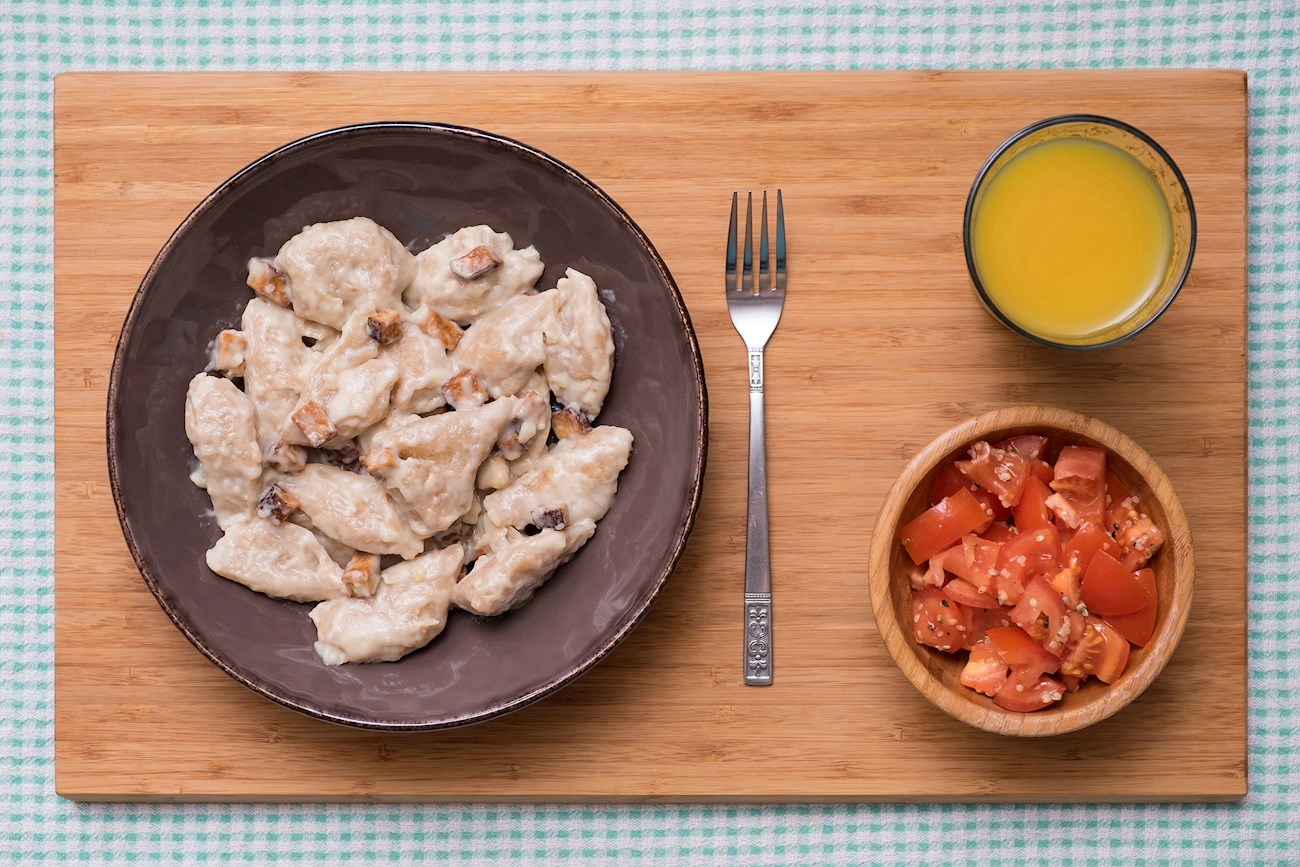TABLE OF CONTENTS
Best Luxembourg Foods
Gromperekichelcher is Luxembourg’s version of a potato pancake. It consists of grated potatoes, shallots, garlic, parsley, eggs, and flour. After the ingredients have been combined, the concoction is typically flavored with salt, pepper, and a pinch of nutmeg, flattened into a small pancake, then fried in hot oil.
These crispy fritters can be consumed on their own as a snack or served as a side dish accompanying a variety of savory dishes.
Kniddelen are traditional Luxembourgish dumplings. They're made with a combination of flour, eggs, and milk. The thick batter is dropped into boiling water by using a teaspoon. When the dumplings rise to the top, they're done. Kniddelen can be served in soups, as accompaniments to stews and casseroles, or more traditionally, combined with bacon that was fried in butter and the accompanying pan juices.
It's recommended to serve the dish with a glass of white Luxembourg wine.
MAIN INGREDIENTS
Judd mat gaardebounen or smoked collar of pork with broad beans is a specialty hailing from Luxembourg. It's often dubbed the national dish of this country. The dish is typically made by cooking the pork collar in water with chopped vegetables and herbs such as leeks, carrots, onions, celery, bay leaves, cloves, savory, and peppercorns (with the addition of wine) until the meat becomes tender.
The cooked smoked pork collar is then cut into slices and combined with a creamy sauce based on roux, fresh cream, dry white wine, stock or water, blanched broad beans, bacon, and herbs before it is enjoyed with a side of boiled or fried potatoes.
Early summer is the period when this specialty is traditionally prepared in Luxembourg’s households and restaurants due to the fact that the beans are young, tender, and fresh during the period.
Verwurelter are traditional Luxembourgish donuts that are made with a combination of flour, butter, yeast, warm milk, sugar, eggs, and salt. The dough mixture is shaped into knots and then deep-fried until golden brown. Light and fluffy, these donuts are typically dusted with powdered or granulated sugar, and they can be enjoyed warm or chilled.
In Luxembourg, verwurelter is a festival staple that is traditionally prepared for Fuesecht, the Luxembourgish equivalent of the German Fasching or Karnival.
Luxembourgish Esaü soup is a hearty lentil stew made by cooking lentils with herbs and vegetables such as onions, carrots, celery, and leeks. The dish is typically seasoned with salt and pepper, and it can optionally be enhanced with ingredients such as various spices, smoked bacon, butter, and cream or milk.
This simple stew derives its name from Esau, a character mentioned in the Old Testament who was the son of Isaac and Rebecca, and the one who sold his birthright to his younger brother, Jacob, for a bowl of stewed lentils (a "mess of pottage"). The dish is also commonly referred to as Jacob's lentil stew or Esau's pottage.
A chicken specialty hailing from Luxembourg, hong am rèisleck consists of chicken smothered in a creamy Riesling wine sauce. Pieces of chicken are first browned in melted butter, then combined with shallots, garlic, mushrooms, chicken stock, heavy cream, flour, egg yolks, Riesling wine, and cognac or sherry, and cooked until done.
The dish is typically seasoned with nutmeg, parsley, salt, and pepper, and it is usually enjoyed poured over hot buttered noodles, but it can also be accompanied by dumplings and seasonal vegetables on the side.
This simple Luxembourgish onion soup is made by stir-frying onions in butter before cooking them in vegetable stock with white wine and caraway seeds. The piping hot soup is then transferred to warmed soup bowls or cups and finished with pieces of toasted bread, sunflower seeds, and grated cheese on top.
Once assembled, öennenzop is broiled until the cheese on the top melts, and all that's left is to dig in and enjoy.
Mummentaart is a traditional Luxembourgish pie or tart filled with a cinnamon-flavored apple filling. The dough is made by combining flour, butter, quark, water, and salt, while the filling typically consists of sliced or cubed slightly sour apples that are sprinkled with sugar, cinnamon, and lemon juice, then mixed with raisins.
A layer of dough is placed inside a baking tin, and it is then covered with the apple filling before being finished with another layer of dough on top, glazed with beaten egg yolks, and baked until nicely colored and done. Slices of this scrumptious apple pie can be enjoyed both warm and chilled, and they are often accompanied by a dollop of whipped cream or fresh fruit on the side.
Salaisons Fumées - Marque Nationale Grand-Duché de Luxembourg are hams made with legs of pork which must carry the national protected Luxembourg brand name for pork or the equivalent foreign designation. The ham has a distinctive flavor owed to the long curing time of at least 10 months and the smoking process, which is typical for Luxembourg hams.
The hams are thoroughly examined before being placed on the market and branded with a special stamp. Although this product is made throughout the whole year, the production usually takes place during the autumn and winter months. These hams are made in a traditional way by approximately 20 butchers or sausage makers.
Bouneschlupp is a classic Luxembourgish soup made with green beans, potatoes, smoked bacon, and onions. Regional variations of this dish may include additional ingredients such as carrots, leeks, or celery. Metworst or other types of heavily spiced sausages may be added as well.
Although bouneschlupp is considered a national dish of Luxembourg, it can also be found in the German state of Saarland, Lorraine (France), and the historical regions of Gaume and Arelerland in Belgium. It is traditionally served hot with potato pancakes called gromperekichelchen and (optionally) a dollop of sour cream on the side.
TABLE OF CONTENTS
Best Luxembourg Food Producers
AWARDS

World Gin Awards - Country Winner
2022, 2021, 2020
BEST Opyos Beverages S.à r.l. Spirits
AWARDS

Concours Mondial de Bruxelles - Grande Médaille d'or
2022
BEST Caves St Remy-Desom Wines
AWARDS

Decanter World Wine Awards - Best in Show
2017

Decanter World Wine Awards - Platinum
2017
BEST Bernard-Massard Wines
AWARDS

Frankfurt International Trophy - Grand Gold
2019
BEST Schumacher-Knepper Wines
AWARDS

Berlin Wine Trophy - Grand Gold
2019
BEST Domaines Vinsmoselle Wines
Luxlait is the largest dairy cooperative in Luxembourg, founded in 1894. Today, it is known for producing high-quality dairy products, including milk, yogurt, kefir, cream, and other products under its own brand. All products are processed in their modern facility in Roost, near Bissen, using milk exclusively from local producers.
The company takes pride in its commitment to sustainability and eco-friendly practices, including the use of renewable energy sources in production and the implementation of methods to reduce carbon dioxide emissions. Luxlait collaborates with farmers throughout Luxembourg, providing them with support in the form of advice, technology, and resources to maintain high-quality standards.
BEST Luxlait Butters
TABLE OF CONTENTS
Best Luxembourg Food Products
AWARDS

World Gin Awards - Country Winner
2022, 2021
AWARDS

Concours Mondial de Bruxelles - Grande Médaille d'or
2022
AWARDS

World Gin Awards - Country Winner
2020
AWARDS

World Gin Awards - Country Winner
2021
AWARDS

Decanter World Wine Awards - Best in Show
2017
AWARDS

World Gin Awards - Country Winner
2022
AWARDS

World Gin Awards - Country Winner
2021
AWARDS

Frankfurt International Trophy - Grand Gold
2019
AWARDS

Berlin Wine Trophy - Grand Gold
2019
AWARDS

Decanter World Wine Awards - Platinum
2017
TasteAtlas food rankings are based on the ratings of the TasteAtlas audience, with a series of mechanisms that recognize real users and that ignore bot, nationalist or local patriotic ratings, and give additional value to the ratings of users that the system recognizes as knowledgeable. TasteAtlas Rankings should not be seen as the final global conclusion about food. Their purpose is to promote excellent local foods, instill pride in traditional dishes, and arouse curiosity about dishes you haven’t tried.













